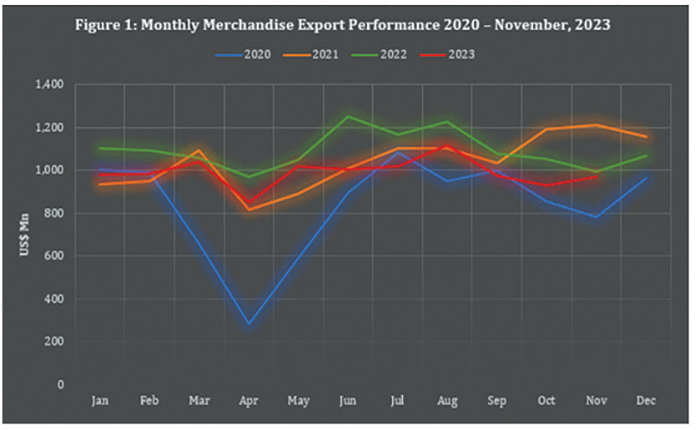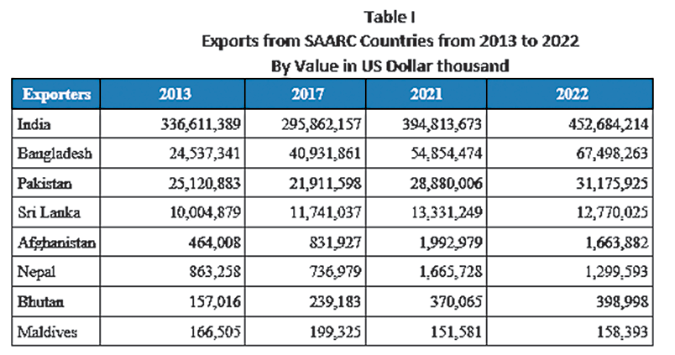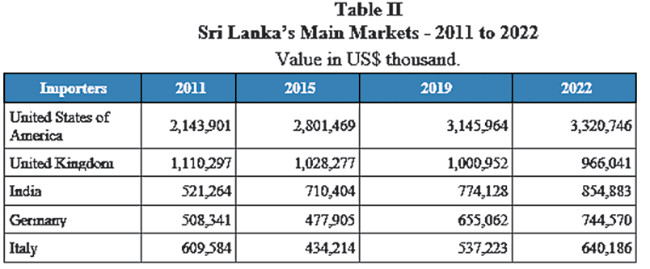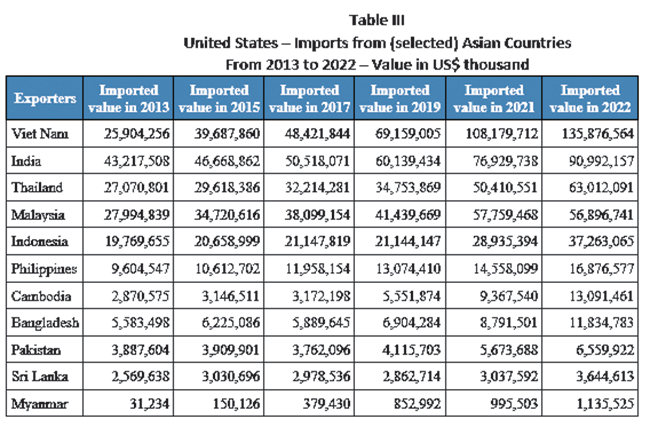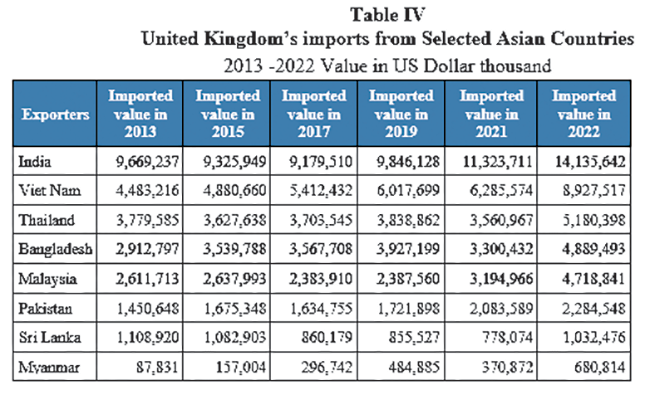Features
Sri Lanka’s exports sliding down a dangerous path

By Gomi Senadhira
Some newspaper headlines, published during the last week of December on Sri Lanka’s achievements on the exports front, provided a welcome relief to many of their readers. “Merchandise exports increase by 4.4% to US$ 968.8 Mn in Nov,” said one. “Agriculture boosts exports in November” said another. We all are aware that the immediate and one of the main reasons for the present crisis was not having sufficient foreign currency reserves that we needed to pay for our imports. One of the main means of earning dollars was exports, earnings from which were always sufficient to pay for our most essential imports. So increased exports was a piece of excellent news at the end of a terrible year as it opens an exit route from the present crisis.
Unfortunately, when one reads beyond headlines the facts provide a different story. Though Sri Lanka’s merchandise exports increased by 4.4 percent to US$ 968.8 million in November 2023, compared to October 2023, the exports decreased by 2.67 percent when compared to the value recorded in November 2022. The fact is that Sri Lanka merchandise exports consistently declined every month during the last year. The information released by the Sri Lanka Export Development Board (EDB) confirms that during the first 11 months of 2023, the cumulative merchandise exports decreased by 9.64 percent (to US$ 10,878.6 million) compared to the corresponding period of 2022. The chart published by the EDB (which is given here) clearly illustrates how the exports have been declining since October 2022. (See Graph)
The decline in export is generally attributed by the EDB to “…to decreased demand for export products, particularly in sectors such as Apparel and Textiles, Rubber and Rubber-based products, and Coconut and Coconut-based products.” If this is correct, then it is possible to assume that we could reverse this slump once the demand picks up. However, if it is also due to the weakening of our competitiveness vis-à-vis our competitors, in our main markets, then the continued decline in exports would be extremely difficult to reverse once the markets start to pick up.
So, what exactly is the situation in the global marketplace?
In October the World Trade Organization (WTO) halved its growth forecast for global goods trade in 2023 from its April estimate of 1.7 percent to o.8% percent. The reasons attributed were persistent inflation, higher interest rates, a strained Chinese property market and the war in Ukraine. The impact of the Israeli–Palestinian (Gaza) conflict was not factored in for that equation. All these mean the slow growth of world trade is a fact that may impact us for next year and beyond. But how have all these impacted our South Asian neighbours?
Merchandise Exports from Bangladesh grew by around 15 percent in the first three months of Bangladesh’s current financial year
(July 23- June 24). But a 13.64 percent year-on-year decrease in October and the 6 percent fall in November dragged down this growth to 1.3 percent by December. The decline during October and November was mainly attributed to a substantial drop in shipments of ready-made garments which had resulted from worker unrest over pay hike demands in the apparel sector. According to media reports, many factories were closed amid violent protests by the workers. However, even under those circumstances, during the January-November period, Bangladesh’s garment export earnings registered a 4.35 percent increase and reached US $ 42.83 billion.
Merchandise exports from Pakistan increased in a sustained manner for the third consecutive month in November
and in the first five months of the current fiscal year (July 23-June 24), cumulative exports had reached US$12.17 billion compared to US$11.94 billion in the corresponding period of the previous year. That is a 1.93 percent increase.
India however experienced a negative growth
as India’s merchandise exports contracted by 6.51 percent year-on-year to $278.8 billion, in the first eight months of the current (Indian) financial year (April 2023- March 2024). Even under these conditions India is expected to register economic growth of 7.3 percent by the end of this fiscal year and is expected to remain the fastest-growing major economy in the world for the next three years.
All these countries are expected to expand their exports, as they have done over the years, once headwinds in the market subside. It appears that during the last year, our South Asian neighbours have managed to deal with the problems in the global marketplace a touch better than us.
Furthermore, unlike our neighbours, Sri Lanka has failed to expand its exports in recent years. During the period 2013 to 2021, Sri Lanka’s exports increased from US$10 billion to US$ 13 billion. Then, in 2022 exports dropped to US$12.7 billion. As shown in Table I, during this period exports from all SAARC countries, other than the Maldives, expanded substantially. Exports from India increased from US$ 336 billion in 2013 to US$ 452 billion in 2022. Exports from Bangladesh increased from US$ 24.5 billion in 2013 to US$ 67.49 billion in 2022. Exports from Pakistan increased from US$ 25 billion to US$ 31 billion. Compared to the growth of exports from those countries, Sri Lanka’s export growth had remained almost stationary. In 2022, India, Bangladesh, and Pakistan managed to increase their exports substantially on year-on –year basis while Sri Lanka’s exports dropped significantly. Table I
stand Sri Lanka’s export performance more clearly it is necessary to evaluate Sri Lanka’s performance in our main markets as against our major competitors. During 2022 the USA, the UK, India, Germany, and Italy were Sri Lanka’s five most important markets. Now, let’s look at how Sri Lanka has done in our two main markets, namely; the United States and the United Kingdom. Table II
United States
Though Sri Lanka’s exports to the United States increased during the last 10 years, from US$ 2,5 billion in 2013 to US$ 3.6 billion to 2022, that growth appears insignificant when compared to the growth achieved by some of our neighbours. During the last 10 years, India increased her exports to the United States from $43 billion to $90.9 billion, Bangladesh from $5.5 billion to $11.8 billion, Thailand from $27 billion to $63 billion and Malaysia from $27.9 billion to $56.8 billion. These countries that managed to double their exports to the United States, the world’s largest market. Vietnam, Cambodia, and Myanmar achieved even better market growth and increased their exports by many folds. Table III
Sri Lanka in the United Kingdom
The United Kingdom’s imports from Sri Lanka have remained almost stagnant during the last 10 years. In 2013, the UK’s total imports from Sri Lanka were recorded at US$1,108 million and this had declined to US$ 1,032 by 2022. However, as illustrated in Table IV, the UK’s imports from most Asian countries had increased significantly during the period. Table IV
Falling exports in an unrelenting manner for two years on the back of insignificant growth over a decade with the prospect of its further deceleration in the months ahead illustrate how uncompetitive Sri Lanka had become in our main markets, not only against East Asian countries but also against South Asian countries.
That explains how even Bangladesh managed to lend us dollars when we had hit rock bottom.
How did Sri Lanka the first country in South Asia to adopt the export-led growth model, become so uncompetitive in the global marketplace during the last 15 years?
Why did the government/s fail to take any meaningful measures to reverse this decline during that period? While trying to find answers to these questions, Sri Lanka needs urgently to focus on its present weaknesses and take immediate remedial steps to make Sri Lanka more competitive in the global market. We all know that the best exit route from the present crises is via increased exports. Through increased exports, we can earn dollars (to pay our debts) and create more jobs. But to do that Sri Lankan firms and the domestic economy need to be competitive vis-à-vis our competitors from the region and elsewhere. For that, we need a national strategy to boost exports. A strategy with immediate, short, medium, and long-term goals.
Today at this stage of an election year, we cannot expect the government to prepare a national strategy that would be accepted by other parties. So, those who are in the export sector, that is; exporters, manufacturers, trade chambers, workers, trade unions, and other stakeholders, should get together with the experts in the field and develop a widely acceptable national strategy to increase the Sri Lanka’s competitiveness and develop exports.
This should be done urgently because in this election year, there is an exceptional opportunity to develop national consensus on export policy and incorporate the main points of that strategy into the election manifestos of all main parties.
(The tables in the study were prepared by the author from International Trade Centre (ITC) data. ITC calculates its data from UN COMTRADE statistics and national trade statistics.)
(The writer, a former Director General of Commerce, can be contacted via senadhiragomi@gmail.com.)
Features
The heart-friendly health minister

by Dr Gotabhya Ranasinghe
Senior Consultant Cardiologist
National Hospital Sri Lanka
When we sought a meeting with Hon Dr. Ramesh Pathirana, Minister of Health, he graciously cleared his busy schedule to accommodate us. Renowned for his attentive listening and deep understanding, Minister Pathirana is dedicated to advancing the health sector. His openness and transparency exemplify the qualities of an exemplary politician and minister.
Dr. Palitha Mahipala, the current Health Secretary, demonstrates both commendable enthusiasm and unwavering support. This combination of attributes makes him a highly compatible colleague for the esteemed Minister of Health.
Our discussion centered on a project that has been in the works for the past 30 years, one that no other minister had managed to advance.
Minister Pathirana, however, recognized the project’s significance and its potential to revolutionize care for heart patients.
The project involves the construction of a state-of-the-art facility at the premises of the National Hospital Colombo. The project’s location within the premises of the National Hospital underscores its importance and relevance to the healthcare infrastructure of the nation.
This facility will include a cardiology building and a tertiary care center, equipped with the latest technology to handle and treat all types of heart-related conditions and surgeries.
Securing funding was a major milestone for this initiative. Minister Pathirana successfully obtained approval for a $40 billion loan from the Asian Development Bank. With the funding in place, the foundation stone is scheduled to be laid in September this year, and construction will begin in January 2025.
This project guarantees a consistent and uninterrupted supply of stents and related medications for heart patients. As a result, patients will have timely access to essential medical supplies during their treatment and recovery. By securing these critical resources, the project aims to enhance patient outcomes, minimize treatment delays, and maintain the highest standards of cardiac care.
Upon its fruition, this monumental building will serve as a beacon of hope and healing, symbolizing the unwavering dedication to improving patient outcomes and fostering a healthier society.We anticipate a future marked by significant progress and positive outcomes in Sri Lanka’s cardiovascular treatment landscape within the foreseeable timeframe.
Features
A LOVING TRIBUTE TO JESUIT FR. ALOYSIUS PIERIS ON HIS 90th BIRTHDAY

by Fr. Emmanuel Fernando, OMI
Jesuit Fr. Aloysius Pieris (affectionately called Fr. Aloy) celebrated his 90th birthday on April 9, 2024 and I, as the editor of our Oblate Journal, THE MISSIONARY OBLATE had gone to press by that time. Immediately I decided to publish an article, appreciating the untiring selfless services he continues to offer for inter-Faith dialogue, the renewal of the Catholic Church, his concern for the poor and the suffering Sri Lankan masses and to me, the present writer.
It was in 1988, when I was appointed Director of the Oblate Scholastics at Ampitiya by the then Oblate Provincial Fr. Anselm Silva, that I came to know Fr. Aloy more closely. Knowing well his expertise in matters spiritual, theological, Indological and pastoral, and with the collaborative spirit of my companion-formators, our Oblate Scholastics were sent to Tulana, the Research and Encounter Centre, Kelaniya, of which he is the Founder-Director, for ‘exposure-programmes’ on matters spiritual, biblical, theological and pastoral. Some of these dimensions according to my view and that of my companion-formators, were not available at the National Seminary, Ampitiya.
Ever since that time, our Oblate formators/ accompaniers at the Oblate Scholasticate, Ampitiya , have continued to send our Oblate Scholastics to Tulana Centre for deepening their insights and convictions regarding matters needed to serve the people in today’s context. Fr. Aloy also had tried very enthusiastically with the Oblate team headed by Frs. Oswald Firth and Clement Waidyasekara to begin a Theologate, directed by the Religious Congregations in Sri Lanka, for the contextual formation/ accompaniment of their members. It should very well be a desired goal of the Leaders / Provincials of the Religious Congregations.
Besides being a formator/accompanier at the Oblate Scholasticate, I was entrusted also with the task of editing and publishing our Oblate journal, ‘The Missionary Oblate’. To maintain the quality of the journal I continue to depend on Fr. Aloy for his thought-provoking and stimulating articles on Biblical Spirituality, Biblical Theology and Ecclesiology. I am very grateful to him for his generous assistance. Of late, his writings on renewal of the Church, initiated by Pope St. John XX111 and continued by Pope Francis through the Synodal path, published in our Oblate journal, enable our readers to focus their attention also on the needed renewal in the Catholic Church in Sri Lanka. Fr. Aloy appreciated very much the Synodal path adopted by the Jesuit Pope Francis for the renewal of the Church, rooted very much on prayerful discernment. In my Religious and presbyteral life, Fr.Aloy continues to be my spiritual animator / guide and ongoing formator / acccompanier.
Fr. Aloysius Pieris, BA Hons (Lond), LPh (SHC, India), STL (PFT, Naples), PhD (SLU/VC), ThD (Tilburg), D.Ltt (KU), has been one of the eminent Asian theologians well recognized internationally and one who has lectured and held visiting chairs in many universities both in the West and in the East. Many members of Religious Congregations from Asian countries have benefited from his lectures and guidance in the East Asian Pastoral Institute (EAPI) in Manila, Philippines. He had been a Theologian consulted by the Federation of Asian Bishops’ Conferences for many years. During his professorship at the Gregorian University in Rome, he was called to be a member of a special group of advisers on other religions consulted by Pope Paul VI.
Fr. Aloy is the author of more than 30 books and well over 500 Research Papers. Some of his books and articles have been translated and published in several countries. Among those books, one can find the following: 1) The Genesis of an Asian Theology of Liberation (An Autobiographical Excursus on the Art of Theologising in Asia, 2) An Asian Theology of Liberation, 3) Providential Timeliness of Vatican 11 (a long-overdue halt to a scandalous millennium, 4) Give Vatican 11 a chance, 5) Leadership in the Church, 6) Relishing our faith in working for justice (Themes for study and discussion), 7) A Message meant mainly, not exclusively for Jesuits (Background information necessary for helping Francis renew the Church), 8) Lent in Lanka (Reflections and Resolutions, 9) Love meets wisdom (A Christian Experience of Buddhism, 10) Fire and Water 11) God’s Reign for God’s poor, 12) Our Unhiddden Agenda (How we Jesuits work, pray and form our men). He is also the Editor of two journals, Vagdevi, Journal of Religious Reflection and Dialogue, New Series.
Fr. Aloy has a BA in Pali and Sanskrit from the University of London and a Ph.D in Buddhist Philosophy from the University of Sri Lankan, Vidyodaya Campus. On Nov. 23, 2019, he was awarded the prestigious honorary Doctorate of Literature (D.Litt) by the Chancellor of the University of Kelaniya, the Most Venerable Welamitiyawe Dharmakirthi Sri Kusala Dhamma Thera.
Fr. Aloy continues to be a promoter of Gospel values and virtues. Justice as a constitutive dimension of love and social concern for the downtrodden masses are very much noted in his life and work. He had very much appreciated the commitment of the late Fr. Joseph (Joe) Fernando, the National Director of the Social and Economic Centre (SEDEC) for the poor.
In Sri Lanka, a few religious Congregations – the Good Shepherd Sisters, the Christian Brothers, the Marist Brothers and the Oblates – have invited him to animate their members especially during their Provincial Congresses, Chapters and International Conferences. The mainline Christian Churches also have sought his advice and followed his seminars. I, for one, regret very much, that the Sri Lankan authorities of the Catholic Church –today’s Hierarchy—- have not sought Fr.
Aloy’s expertise for the renewal of the Catholic Church in Sri Lanka and thus have not benefited from the immense store of wisdom and insight that he can offer to our local Church while the Sri Lankan bishops who governed the Catholic church in the immediate aftermath of the Second Vatican Council (Edmund Fernando OMI, Anthony de Saram, Leo Nanayakkara OSB, Frank Marcus Fernando, Paul Perera,) visited him and consulted him on many matters. Among the Tamil Bishops, Bishop Rayappu Joseph was keeping close contact with him and Bishop J. Deogupillai hosted him and his team visiting him after the horrible Black July massacre of Tamils.
Features
A fairy tale, success or debacle

Sri Lanka-Singapore Free Trade Agreement
By Gomi Senadhira
senadhiragomi@gmail.com
“You might tell fairy tales, but the progress of a country cannot be achieved through such narratives. A country cannot be developed by making false promises. The country moved backward because of the electoral promises made by political parties throughout time. We have witnessed that the ultimate result of this is the country becoming bankrupt. Unfortunately, many segments of the population have not come to realize this yet.” – President Ranil Wickremesinghe, 2024 Budget speech
Any Sri Lankan would agree with the above words of President Wickremesinghe on the false promises our politicians and officials make and the fairy tales they narrate which bankrupted this country. So, to understand this, let’s look at one such fairy tale with lots of false promises; Ranil Wickremesinghe’s greatest achievement in the area of international trade and investment promotion during the Yahapalana period, Sri Lanka-Singapore Free Trade Agreement (SLSFTA).
It is appropriate and timely to do it now as Finance Minister Wickremesinghe has just presented to parliament a bill on the National Policy on Economic Transformation which includes the establishment of an Office for International Trade and the Sri Lanka Institute of Economics and International Trade.
Was SLSFTA a “Cleverly negotiated Free Trade Agreement” as stated by the (former) Minister of Development Strategies and International Trade Malik Samarawickrama during the Parliamentary Debate on the SLSFTA in July 2018, or a colossal blunder covered up with lies, false promises, and fairy tales? After SLSFTA was signed there were a number of fairy tales published on this agreement by the Ministry of Development Strategies and International, Institute of Policy Studies, and others.
However, for this article, I would like to limit my comments to the speech by Minister Samarawickrama during the Parliamentary Debate, and the two most important areas in the agreement which were covered up with lies, fairy tales, and false promises, namely: revenue loss for Sri Lanka and Investment from Singapore. On the other important area, “Waste products dumping” I do not want to comment here as I have written extensively on the issue.
1. The revenue loss
During the Parliamentary Debate in July 2018, Minister Samarawickrama stated “…. let me reiterate that this FTA with Singapore has been very cleverly negotiated by us…. The liberalisation programme under this FTA has been carefully designed to have the least impact on domestic industry and revenue collection. We have included all revenue sensitive items in the negative list of items which will not be subject to removal of tariff. Therefore, 97.8% revenue from Customs duty is protected. Our tariff liberalisation will take place over a period of 12-15 years! In fact, the revenue earned through tariffs on goods imported from Singapore last year was Rs. 35 billion.
The revenue loss for over the next 15 years due to the FTA is only Rs. 733 million– which when annualised, on average, is just Rs. 51 million. That is just 0.14% per year! So anyone who claims the Singapore FTA causes revenue loss to the Government cannot do basic arithmetic! Mr. Speaker, in conclusion, I call on my fellow members of this House – don’t mislead the public with baseless criticism that is not grounded in facts. Don’t look at petty politics and use these issues for your own political survival.”
I was surprised to read the minister’s speech because an article published in January 2018 in “The Straits Times“, based on information released by the Singaporean Negotiators stated, “…. With the FTA, tariff savings for Singapore exports are estimated to hit $10 million annually“.
As the annual tariff savings (that is the revenue loss for Sri Lanka) calculated by the Singaporean Negotiators, Singaporean $ 10 million (Sri Lankan rupees 1,200 million in 2018) was way above the rupees’ 733 million revenue loss for 15 years estimated by the Sri Lankan negotiators, it was clear to any observer that one of the parties to the agreement had not done the basic arithmetic!
Six years later, according to a report published by “The Morning” newspaper, speaking at the Committee on Public Finance (COPF) on 7th May 2024, Mr Samarawickrama’s chief trade negotiator K.J. Weerasinghehad had admitted “…. that forecasted revenue loss for the Government of Sri Lanka through the Singapore FTA is Rs. 450 million in 2023 and Rs. 1.3 billion in 2024.”
If these numbers are correct, as tariff liberalisation under the SLSFTA has just started, we will pass Rs 2 billion very soon. Then, the question is how Sri Lanka’s trade negotiators made such a colossal blunder. Didn’t they do their basic arithmetic? If they didn’t know how to do basic arithmetic they should have at least done their basic readings. For example, the headline of the article published in The Straits Times in January 2018 was “Singapore, Sri Lanka sign FTA, annual savings of $10m expected”.
Anyway, as Sri Lanka’s chief negotiator reiterated at the COPF meeting that “…. since 99% of the tariffs in Singapore have zero rates of duty, Sri Lanka has agreed on 80% tariff liberalisation over a period of 15 years while expecting Singapore investments to address the imbalance in trade,” let’s turn towards investment.
Investment from Singapore
In July 2018, speaking during the Parliamentary Debate on the FTA this is what Minister Malik Samarawickrama stated on investment from Singapore, “Already, thanks to this FTA, in just the past two-and-a-half months since the agreement came into effect we have received a proposal from Singapore for investment amounting to $ 14.8 billion in an oil refinery for export of petroleum products. In addition, we have proposals for a steel manufacturing plant for exports ($ 1 billion investment), flour milling plant ($ 50 million), sugar refinery ($ 200 million). This adds up to more than $ 16.05 billion in the pipeline on these projects alone.
And all of these projects will create thousands of more jobs for our people. In principle approval has already been granted by the BOI and the investors are awaiting the release of land the environmental approvals to commence the project.
I request the Opposition and those with vested interests to change their narrow-minded thinking and join us to develop our country. We must always look at what is best for the whole community, not just the few who may oppose. We owe it to our people to courageously take decisions that will change their lives for the better.”
According to the media report I quoted earlier, speaking at the Committee on Public Finance (COPF) Chief Negotiator Weerasinghe has admitted that Sri Lanka was not happy with overall Singapore investments that have come in the past few years in return for the trade liberalisation under the Singapore-Sri Lanka Free Trade Agreement. He has added that between 2021 and 2023 the total investment from Singapore had been around $162 million!
What happened to those projects worth $16 billion negotiated, thanks to the SLSFTA, in just the two-and-a-half months after the agreement came into effect and approved by the BOI? I do not know about the steel manufacturing plant for exports ($ 1 billion investment), flour milling plant ($ 50 million) and sugar refinery ($ 200 million).
However, story of the multibillion-dollar investment in the Petroleum Refinery unfolded in a manner that would qualify it as the best fairy tale with false promises presented by our politicians and the officials, prior to 2019 elections.
Though many Sri Lankans got to know, through the media which repeatedly highlighted a plethora of issues surrounding the project and the questionable credentials of the Singaporean investor, the construction work on the Mirrijiwela Oil Refinery along with the cement factory began on the24th of March 2019 with a bang and Minister Ranil Wickremesinghe and his ministers along with the foreign and local dignitaries laid the foundation stones.
That was few months before the 2019 Presidential elections. Inaugurating the construction work Prime Minister Ranil Wickremesinghe said the projects will create thousands of job opportunities in the area and surrounding districts.
The oil refinery, which was to be built over 200 acres of land, with the capacity to refine 200,000 barrels of crude oil per day, was to generate US$7 billion of exports and create 1,500 direct and 3,000 indirect jobs. The construction of the refinery was to be completed in 44 months. Four years later, in August 2023 the Cabinet of Ministers approved the proposal presented by President Ranil Wickremesinghe to cancel the agreement with the investors of the refinery as the project has not been implemented! Can they explain to the country how much money was wasted to produce that fairy tale?
It is obvious that the President, ministers, and officials had made huge blunders and had deliberately misled the public and the parliament on the revenue loss and potential investment from SLSFTA with fairy tales and false promises.
As the president himself said, a country cannot be developed by making false promises or with fairy tales and these false promises and fairy tales had bankrupted the country. “Unfortunately, many segments of the population have not come to realize this yet”.
(The writer, a specialist and an activist on trade and development issues . )

